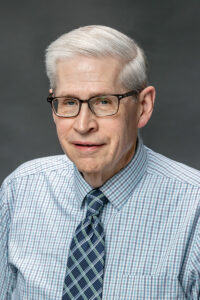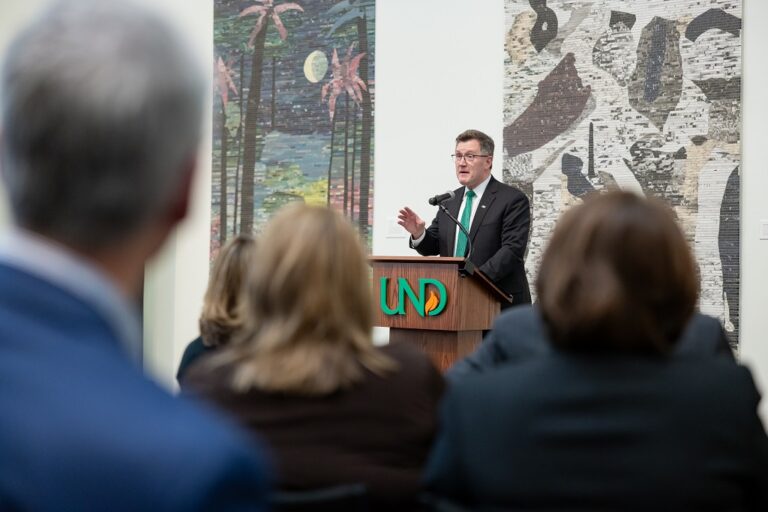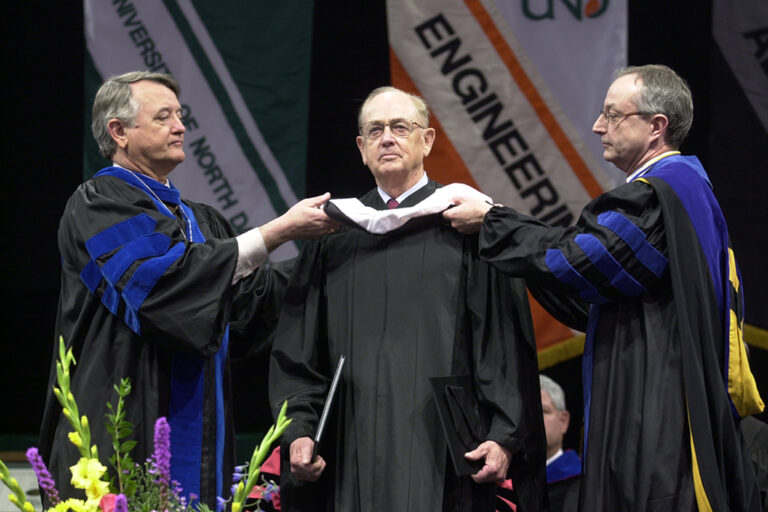UAS degree program reaches 10-year anniversary
UND Aerospace has 225 UAS graduates since program launch in 2009
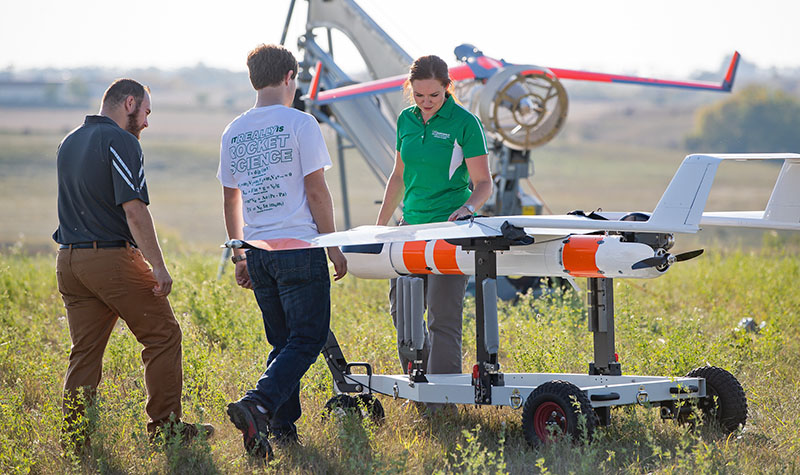
Ten years ago, nobody knew how long it would be before the commercial potential of unmanned aircraft systems would be unleashed.
That didn’t stop UND’s John D. Odegard School of Aerospace Sciences from becoming a leader in the field in 2009, by becoming the first university to offer a degree program in UAS operations. It was the start of many firsts in the field of unmanned aircraft for North Dakota.
According to Al Palmer, the retired director of UND’s Aerospace UAS program, the University began planning its move into UAS in 2005.
“There was no hesitation about it,” Palmer remembered. “Paul Lindseth (current UND Aerospace dean) said at one of our first meetings that we should be running toward this, not walking. UND Aerospace got involved in UAS before anyone could even spell unmanned aircraft systems.”

As UND’s degree program in UAS operations marks its 10-year anniversary from its start, 225 students have graduated from the University with UAS degrees, and 159 students are currently majoring in the subject. Paul Snyder, director of UND’s UAS program, noted that unmanned aviation is on a path to merge with the commercial aviation industry.
“It has been an exciting ride to be a part of such an amazing organization and a group of people who are genuinely dedicated to aviation education, training and research,” Snyder said. “We have seen an evolution in which UAS has become more and more prevalent. As it evolves, I believe we will see it converge in many ways with traditional commercial aviation.”
Launching UAS education
In 2006, Ben Trapnell, associate professor of aviation, was given the task of getting ahead of the coming UAS wave by creating an education program for UND Aerospace. It took three years before everyone was onboard with the program and the State Board of Higher Education gave its approval. The word Trapnell received from industry was that the more future UAS graduates understood about systems engineering, the better.
“We wanted to ensure that our graduates would have the background they needed to be a developmental team member because everything was brand new,” he recalled. “We put together a core of four courses, which involved the unmanned aircraft systems, ground systems, communications and telemetry, and remote sensing. We were the first to come up with an unmanned aircraft system operations degree program.”
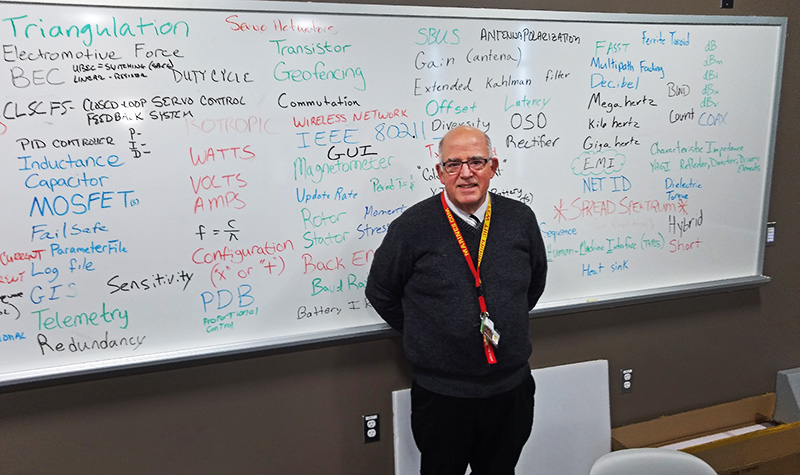
In May 2011, UND graduated its first five students with degrees in UAS operations. All were commercial, instrument-rated pilots, and at least three of them remain employed in the UAS industry. The five graduates were Christopher Burger, Ritzville, Wash.; Jeremy Duke, Everett, Wash.; Adam Julson, Flandreau, S.D.; Alexander Gustafson, Vashon Island, Wash.; and Brett Whalin, Rapid City, S.D.
Trapnell continues to teach students the importance of understanding systems engineering, as well as the aviation engineer’s vocabulary. Students also learn to build their own unmanned aircraft.
“The whole idea of the flight course is that students understand how each of the systems within the system work and how they work together,” he explained. “It is the idea that UAS are systems of systems, and they must work together seamlessly to be successful.
“Whether you’re talking about a large Global Hawk or a small unmanned aircraft like a quadcopter, our students can speak the language and understand the terms when people use them,” Trapnell continued. “Companies such as Northrup Grumman, Insitu and General Atomics have very much appreciated the skillsets our students bring.”
Commercialization when?
When UND’s first UAS graduates entered the job market, there were questions about when the Federal Aviation Administration (FAA) would allow UAS to fly commercial missions.
“I think the FAA finally got the picture that this wasn’t going to go away,” Palmer said. “The FAA’s primary role is aviation safety, and they do an excellent job there. They wanted to make sure unmanned aircraft were safe, but sometimes you need to break the inertia against change. I think we’ve broken it now.”
Snyder points to UND Aerospace’s successes in forming partnerships with the UAS industry. For example, UND last May signed a memo of understanding with General Atomics Aeronautical Systems Inc., a major UAS manufacturer based in California with operations in Grand Forks.
“This is an example of UAS industry leaders working with UND Aerospace to refine our curriculum and to ensure our students are prepared for future employment,” he said. “Similarly, we have been working closely with Boeing subsidiary Insitu in developing our ScanEagle UAS training. They are actively engaged with us to help our students succeed.”
In addition, Snyder said UND students have opportunities for internships with companies such as General Atomics, Northrop Grumman, U.S. Customs and Border Protection and Insitu.
And, he added, “Other students are moving forward in their UAS careers with local entities such as Isight RPV Services, SkySkopes and the Northern Plains UAS Test Site. We are extremely fortunate to have so many leaders in UAS here North Dakota.”

Snyder emphasized that UND Aerospace has a long history of being engaged in shaping UAS policy and regulations, as well as a reputation for overall excellence in education and research. UND Aerospace was recently named the first ASTM International-certified UAS training facility.
“We have been fortunate to be a part of leading research for the FAA through the Alliance for System Safety of UAS through Research Excellence (ASSURE), as well as other research opportunities with the Air Force Research Lab, Department of Homeland Security, NASA and the Northern Plains UAS Test Site,” Snyder said.
Evolving UAS curriculum
As the UAS industry changes, UND’s UAS curriculum is evolving to keep pace.
“Last year, we updated our curriculum to include additional courses to help prepare our students for the industry,” Snyder noted. “We added autonomous fundamentals, enabling concepts and counter-UAS courses. We improved courses to include more post-processing and data-collection experience. We also provided students with a choice of two tracks to specialize in the type of UAS operations they intend to pursue.”
One track focuses on medium-sized, high-altitude, long-endurance UAS with training on the Insitu ScanEagle and General Atomics UAS platforms. The second focuses on advanced commercial operations for small UAS with training on the Professional DJI M600 and Insitu ScanEagle platforms. UND Aerospace now also offers a UAS minor for all non-aviation degree-seeking students.
Another addition to the curriculum is the Simlat UAS Simulation, which enables students to train in simulated environments for such commercial UAS missions as inspecting pipelines, power lines, wind turbines and industrial facilities. Snyder said it gives UAS and commercial aviation students the ability to see how unmanned aircraft are being used to transform the aviation industry.
A recent change requires all future UND Aerospace commercial aviation students to take the Introduction to UAS Operations class, which says something of the expected progress of UAS operating in the national airspace system, Snyder said.
“The integration of UAS into the national airspace system is going to happen,” he said. “Equally important, the technology and advancements in autonomous systems we are developing in UAS will make their way to manned aircraft. Students who want to be involved in traditional commercial aviation will need to understand what autonomous fundamentals mean, what issues we have in cyber security and how concepts like data links will be important to all pilots.”
Looking ahead to the next 10 years, Snyder said UND Aerospace will continue to add value for its UAS graduates in an ever-changing market.
“We often tell our students that the jobs of today won’t be the same jobs in four years,” he explained. “Therefore, we need to prepare students to adapt, solve problems and use critical thinking skills.”
